The Big List: 21 Moving Wave Technologies and How They Work
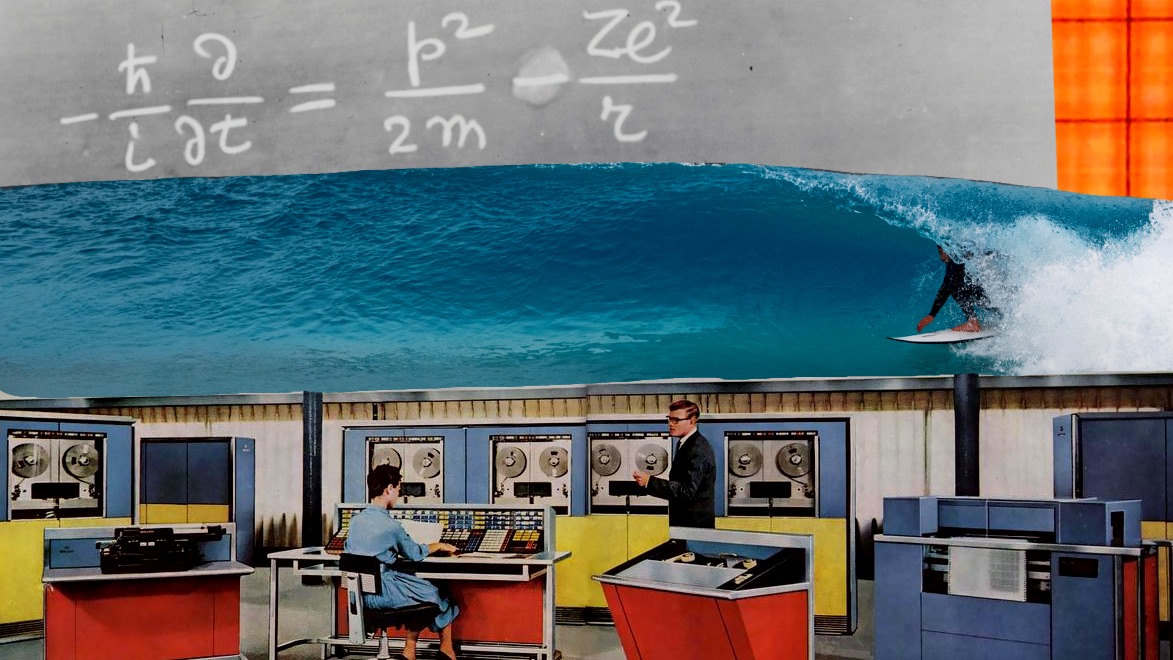
How Do Wave Pools Work? There are several wave pool technologies on the market today that create surf with plows, paddles, levers, plungers and pneumatic systems. These devices are controlled by sophisticated software and motors. When activated in sequence they displace water to produce waves in the desired height or shape.
Wave Technology Companies Today Include: The Kelly Slater Wave Co., Endless Surf, Surf Loch, Wavegarden Cove, Wavegarden Lagoon, AllWaves, PerfectSwell, Murphys Waves, Barr+Wray, Xing Feng, Olas, SwellSpot, Surfwrld, Waveprizm, SwellMFG, OkahinaWave, Webber Wave Pools, WaveSEG, Surf Lakes, Surf Poel, Surfpark Resort
You can also check our company-by-company guide here.
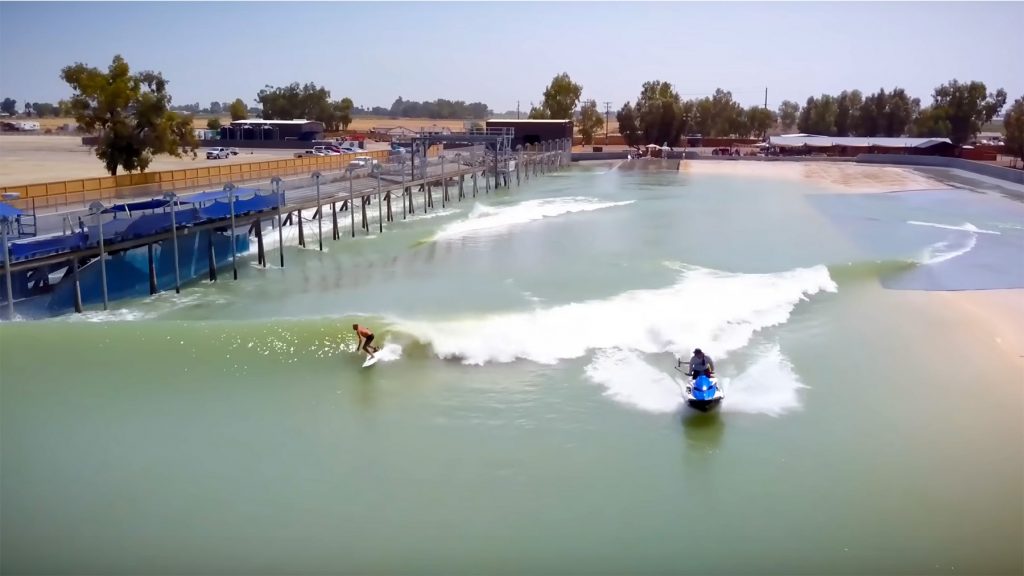
Kelly’s design is the most famous of the wave pools. The prototype transformed an abandoned waterski park in Lemoore California into the upscale Surf Ranch, the darling of the WSL and company team-building power perk for the Fortune 500 surf set. The system is a simple plow design, like Wavegarden’s Lagoon and Surf Poel in The Hague. A specially designed submerged foil is pulled down a straight track at high (or low) velocity, displacing water to create a wave that breaks along the wave pool’s specially designed bathymetry. Adjustments to the large, noisy machine temper the speed of the plow affecting the wave’s steepness and size. Unlike the Wavegarden Lagoon, Kelly’s wave plow only generates a rideable swell on one side of the track. But it is bi-directional, going in one direction to create lefts and the other direction to create rights.
The pool is 700 meters long by 150 meters wide with the ride at Kelly’s, clocking in at 45 seconds – the longest of any of the world’s wave pools to date. A wave is generated about every two minutes and ranges in size from 3-to-6-feet. The company has suffered setbacks in Florida, Coolum Australia and elsewhere as they struggle to make the system cost-effective for the work-a-day surfer while getting approval from local authorities. Plans to expand elsewhere in Australia and in Texas, as well as Japan, are hot with speculation as the world anticipates the first public dream wave. A development for a Kelly Slater Wave Co tank in the desert east of Los Angeles is moving forward rapidly.
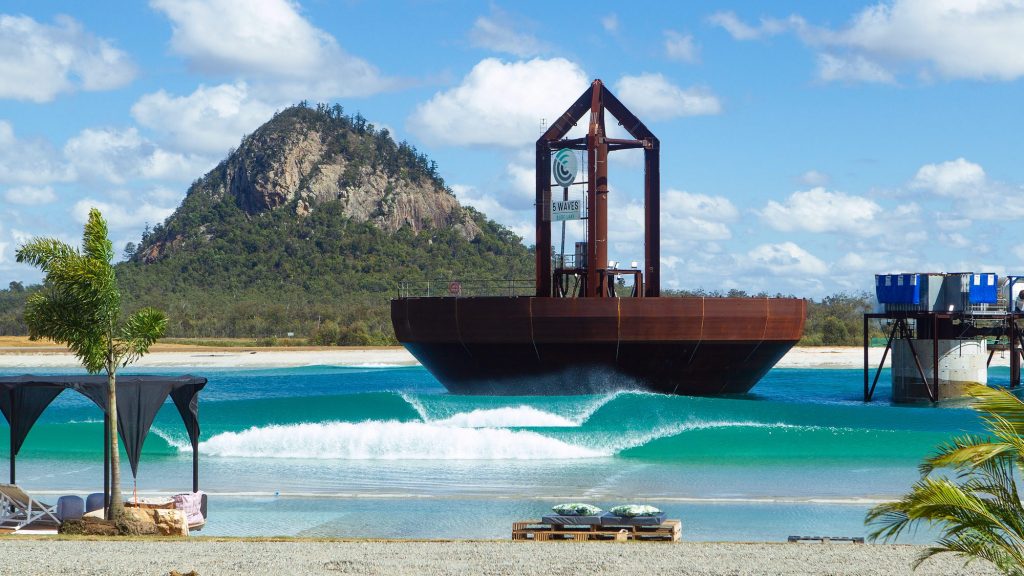
Anyone who has tossed a rock into still water and watched the ripples fan out comprehends the Surf Lakes system. Mix in elementary bathymetry knowledge and each one of us believes we could design such a machine. But we can’t. A pneumatic system pumps hydraulics to move a giant central plunger up and down at a specified height and speed. Adjustments to the height and velocity at which the plunger is dropped, affect the intensity and size of the waves. Once the central wave-making device falls in a pre-programmed manner, swells radiate out in 360-degrees. The swells interact with up to five different breaks to create a wide variety of surf across all skill levels. Surf Lakes can produce 2000 waves per hour at anywhere from 2-to-8 feet in height. Popular and internet celebrity breaks include The Island, Occy’s Peak and a level 3 wave groomed for aerials. The other breaks are designed for beginners and intermediates.
The breadth and scope of building one of these wave pools can be daunting, and Surf Lakes now offers two sizes for different development targets and budgets. Surf Lakes Standard has a smaller footprint and is designed for the beginner to intermediate markets. Surf Lakes XL is meant to be a premium surf destination or resort appealing to all skill levels. Each system produces 2000 waves per hour. Currently, the prototype in Yeppoon Queensland is becoming a public-facing surf park.
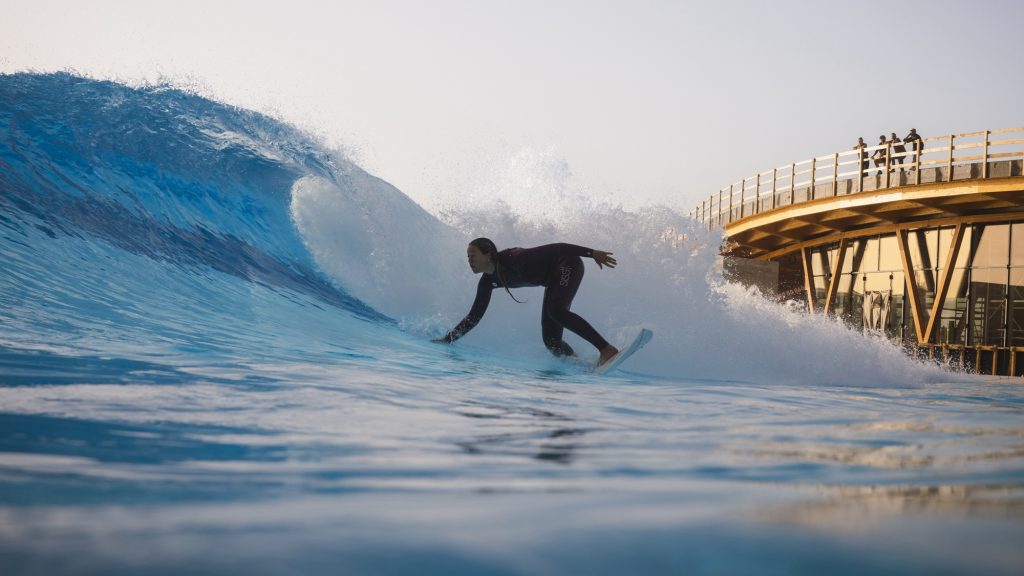
Endless Surf is another one of the major pneumatic systems on the market today. Surf is created when air is pushed through caissons (chambers) in sequence to produce a variety of wave shapes and sizes. The number of caissons at the deep end of their heart-shaped pool correlates with the wave system’s size. An Endless Surf 1800 has 18 pneumatic chambers and an Endless Surf 4800 has 48 caissons and measures 282m (925.2ft) x 84.5m (277.2ft). The system can go even larger and offer 32-second rides on the single peak setting which travels the length of the pool. Wave heights will run at 2-3 ft on average but can go up to 7 feet as both lefts and rights. Length of a ride for the small Endless Surf pool is expected to be 30-60 yards/meters but can go up to 200 meters in their maximum-sized pool. The system has the capability to produce 400-700 waves per hour.
As pneumatics become the daily driver for many wave pool systems, the thing that sets the Endless Surf system apart is the wide variety of surf they can offer within the same session via their Swell Studio software. The synching and firing of pneumatics is controlled by the new patented software that can be customized for each individual surfer sharing the same block of surf time. Riders either wear an RFID wristband or place it on their board to activate the computer with their pre-loaded wave choices. Experts get expert waves, intermediates get intermediate waves. Once deployed, this system will save surf parks from booking solely “expert” or “intermediate” sessions.
As of this writing, there is no full-scale prototype for Endless Surf. We’ve included Endless Surf in this guide because the company behind them is Canada’s Whitewater, a giant in the waterpark business that has a deep understanding of pool construction and master planning processes. Currently, there are plans for Endless Surf pools in Melbourne, the Gold Coast, Liverpool, Vietnam, Dominican Republic, Paris and several other locations throughout the USA.
ENDLESS SURF – Shaping the Future of Surf Parks from Endless Surf on Vimeo.
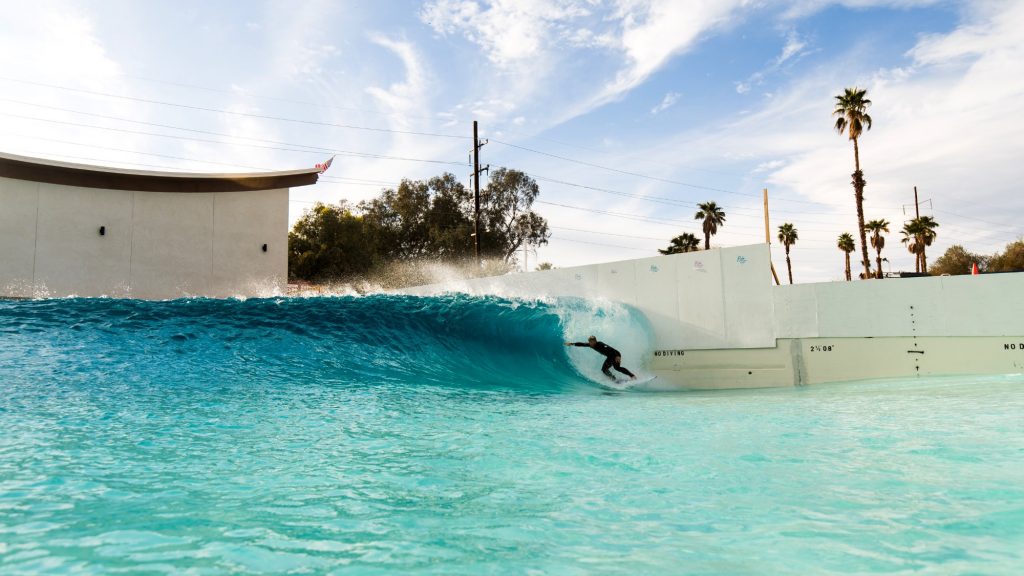
Wave pool OG scientist Tom Lochtefeld finally saw his design come to light in 2020. After years of test tanks and sketches, the inventor of the FlowRider pumped out waves at an abandoned water park in the desert. SurfLoch’s technology uses pneumatic systems within big caissons (a watertight concrete or metal chamber) that push out air to displace water and create a wave. When wave programmers fire the chambers in a specific sequence, any number of wave types can be created. The test pool at Palm Springs Surf Club has six to eight of these chambers, a full-size SurfLoch design can go up to 24 chambers.
Wave sizes range from 2-to-6-feet with the ability to go bigger in the right setting. Waves can be created to break right, left or as a central peak producing both a right and a left. The length of the ride depends on the size of the pool and the number of swell-producing chambers. The Palm Springs test pool offers six-second rides but the full-scale pool will offer 16-second rides. The wave firing and customization is controlled by Siemens software. Tom’s technology is benefitting greatly under the knob-twirling of Cheyne Magnusson who created many of BSR Surf Resort’s branded wave settings. Surf Loch currently has projects ongoing in Spain, Australia, The USA and beyond.
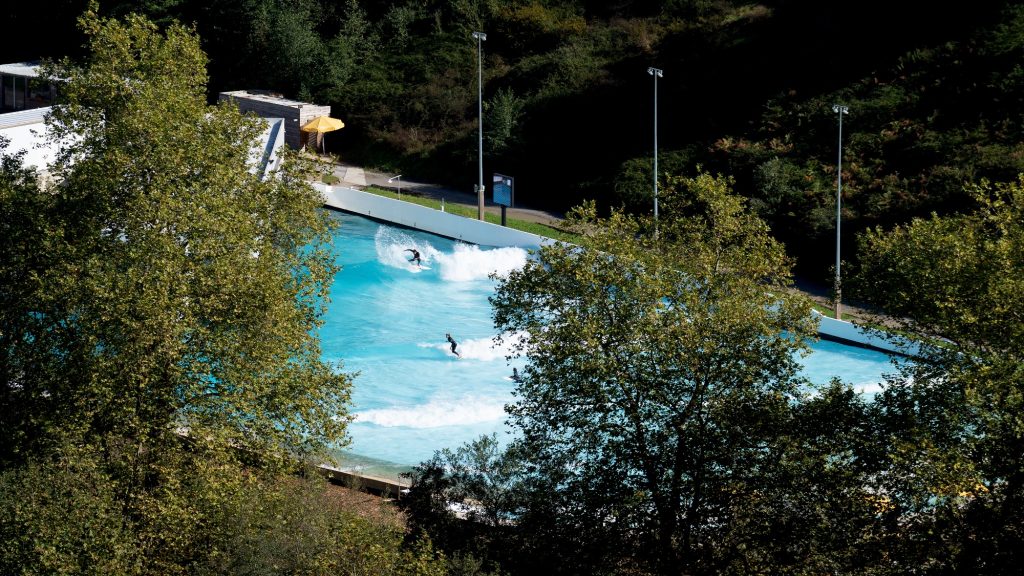
Wavegarden developed the Cove system shortly after their groundbreaking Lagoon design. Where the Lagoon had limitations in wave count and variety, the Cove resolved these issues critical to a profitable surf park. The system is a diamond-shaped pool with a customizable pier or footbridge running through the center. The top end of the pier houses the machinery that pushes out waves through a series of levers encased in modules. The levers swing in one direction to push out a wave on one side of the pool, then carry that inertia back to the other side of the module, pushing out a wave on the other side of the pool – which makes for an energy-efficient system. As the wave refracts and moves along the wall it gets further enhancement from the other modules.
In broad strokes, the number of modules determines wave length and power. The Wavegarden test facility in the Basque Country of Spain has 28 modules and provides a short right-hander, while Melbourne and Bristol boast 46 modules. The super wave pool in South Korea has 56 modules. Each additional module shapes the wave according to the engineer’s or programmer’s desired end-product. Famous settings include the Beast tube riding specialty wave and the extremely popular Turns waves. The Cove produces surf in the 2-to-7 foot range as only rights on one side of the pier and only lefts on the other side. There is no peak setting with split rights and lefts.
One of the first to market, Wavegarden Cove systems are in place at some of the world’s most popular surf parks including Wave Park South Korea, The Wave in Bristol, Alaia Bay in Switzerland and Urbnsurf in Melbourne. At the time of this writing, the company is developing roughly 30 additional projects globally.
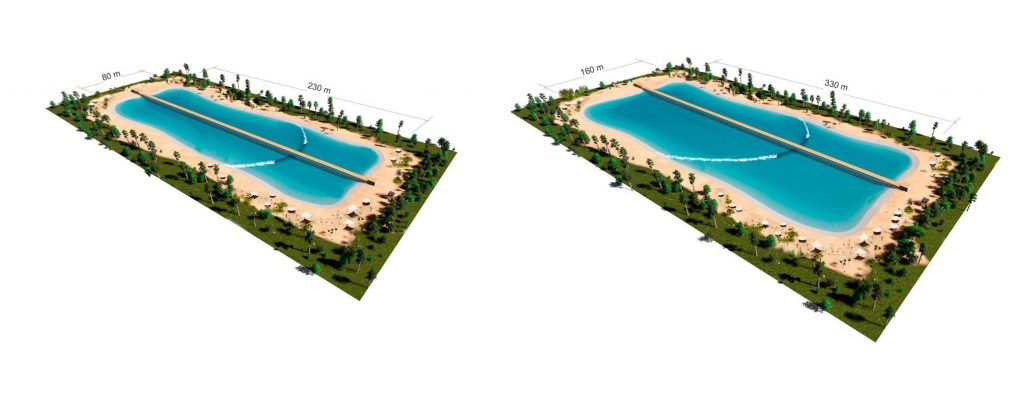
The first of the wave pool 2.0 generation to break ground nearly a decade ago is alive and well at Adventure Parc Snowdonia. This is the beast that launched the whole revolution while Kelly, Greg Webber, Lochtefeld and others were still in the lab. Developed deep in the Basque Country of Spain, the world woke to the Lagoon in 2010 via low-res YouTube videos. With the prototype an hour drive from Hossegor, Wavegarden’s launch benefited greatly from traveling CT pros who made the small waves look doable. This first prototype, a plastic-lined pond about the size of your corner 7-Eleven, gave way to a revamped design in a larger pond. This larger model showed us the full potential and included a pier running down the center of the wave pool. The first full-scale Lagoon went up at Surf Snowdonia in 2015. Another one opened in Austin Texas shortly afterward.
The system works like Kelly’s wave system and the China wave pool. A submerged hydrodynamic wave foil (hull) powered by a gearless drive system runs down a central track that splits the rectangular lagoon. The hull moves at a speed between 4.5m and 7.5m (14.7ft-24.6ft) per second and pushes out a large wake that breaks along either side of a central pier creating a right and a left simultaneously. Speed of the foil determines the size of the wave generated. Once the swell is pushed out it interacts with the shallows of the lagoon bathymetry to form the wave we see today. A right and a left between 2-to- 6-feet high on the face can be generated roughly every 90 seconds with rides up to 30 seconds long. Despite commercial viability obstacles including a low waves-per-hour count and the pool requiring a long, straight piece of land, the lagoon started the wave pool revolution we see today and anchors the ever-popular Adventure Parc Snowdonia facility in Wales.
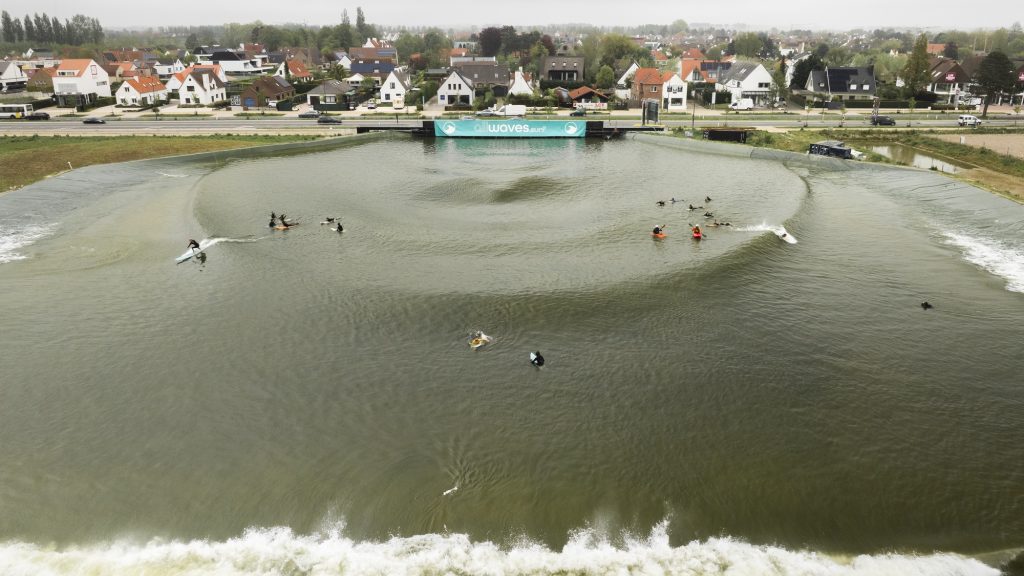
AllWaves uses an underwater textile system powered by exterior hydraulics. They call this machine the “wavemaker.” When the wavemaker pushes out waves they break along a reef on each side of the pool. This creates right and left point break waves down the length of the pool. A second reef is situated at the front of the main pool. It’s an A-frame reef and offers another two surf rides, this time along the width of the pool. This means that on every single wave generated, four surfers can enjoy a ride: two on the point (right and left, lengthways) and two on the A frame reef (right and left, widthways).
The heart of the technology is a high-tech textile submerged in the centre of the pool. It is a soft structure without grids, nets, ropes, or other components – the membrane can be best compared to a bouncy castle but filled with water. Each section of the membrane can be adjusted to pull or push water. It’s these actions that create swell at the water’s surface. The hydraulic power system is in a dedicated room outside of the pool and can be maintained just like an ordinary hydraulic installation.
AllWaves says that there are just a few parts under the membrane used to manipulate the textile.The makers claim the system can vary not only waves but also the parts of the wave. For each setting, the face, pocket, lip, and the white water can be programmed by the company’s software’s algorithm. Wave production is constant with no lulls and a wave produced each seven seconds, so 500 waves per hour. Each wave can accomodate four surfers – two on the point and two on the reef each going left and right. AllWaves says this translates to 2000 rides per hour.Currently, the prototype is being constructed in Knokke-Heist, Belgium. The membrane will be installed in April and tests will run from May onward. Stay tuned…
American Wave Machines/PerfectSwell
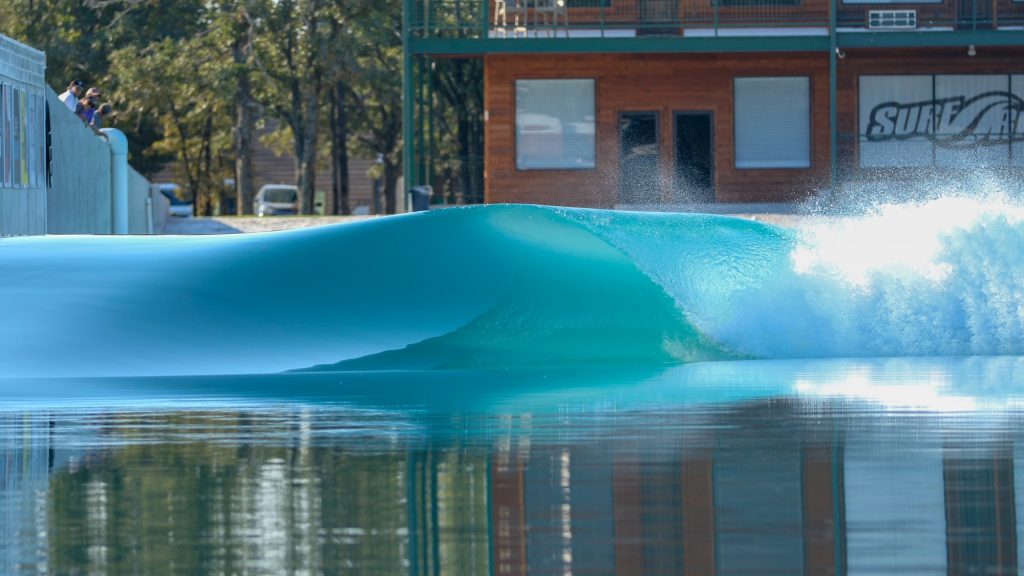
PerfectSwell uses a pneumatic system similar to Endless Surf, SurfLoch and others. While there are nuances to the systems that come through in the patents and are obvious to engineers, it’s basically air pushed into the water to create waves. The pneumatics are housed in caissons hidden in a central wall. Software controls the firing sequence of the chambers and the timing and force of the release air. The result is the creation of waves of many different types. At BSR in Waco Texas, PerfectSwell creates both lefts and rights, but only one at a time. Their smaller system in New Jersey at the American Dream Mall offers a split peak wave.
BSR Surf Resort in Texas uses American Wave Machines’ PerfectSwell system and has become the internet darling thanks to the wide array of air waves the system can create. Famous branded waves include the Freak Peak, the Seabass Ramp and Mason Ho’s tube-to-air setting. Waves in Waco average 30-60 yards/meters, and tend to be semi-hollow to hollow and performance-oriented although short intermediate and beginner surf is available from the system as well. Rides at BSR run about 10 seconds in duration with New Jersey clocking in at between 3-8 seconds depending on the setting. The design creates 120 -160 waves per hour which come in three-wave sets at between 1:10-1:30 apart. Waves created are roughly 2-to- 6-feet but can go bigger. The PerfectSwell system has ongoing projects in Japan, Brazil and Australia.
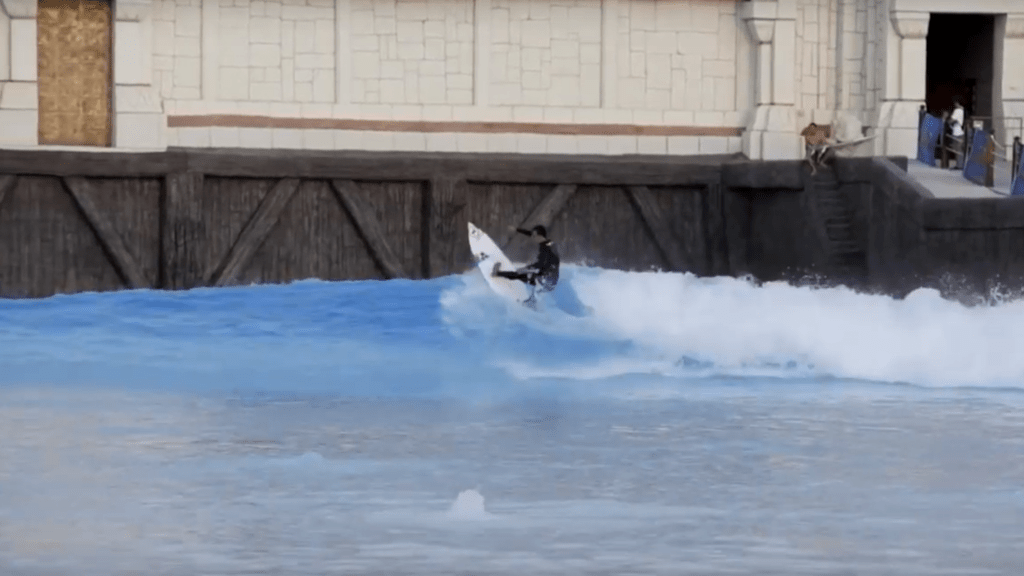
Murphys (no apostrophe) system works in the classic pump-and-dump fashion. Water fills tanks in the deep end of the pool and is then released in sequence to create the desired wave shape and size. That wave then moves out from the narrow end of the pool into a wide bay, expanding and weakening as it travels. Murphy’s waves systems typically creates lefts, rights and split peaks in the 2-to-6-foot range. Murphys stated in an email that “Siam Park, which opened almost 15 years ago, is well noted on achieving wave heights at 3.3m (11 feet).” WavePoolMag is waiting for photographic or video proof of this achievement.
While the wave quality isn’t the same as the newer techs, the company has hinted that there is something on the horizon designed for entry into the surf pool market. Murphys says their new Turtle Back wave pool generates two large waves simultaneously from a central platform in an oval-shaped pool. The design will be implemented at several new water parks in China according to company materials. Siam Park in the Canary Islands is powered by Murphys Waves and has starred in several surf videos including Lost Atlas by Kai Neville.
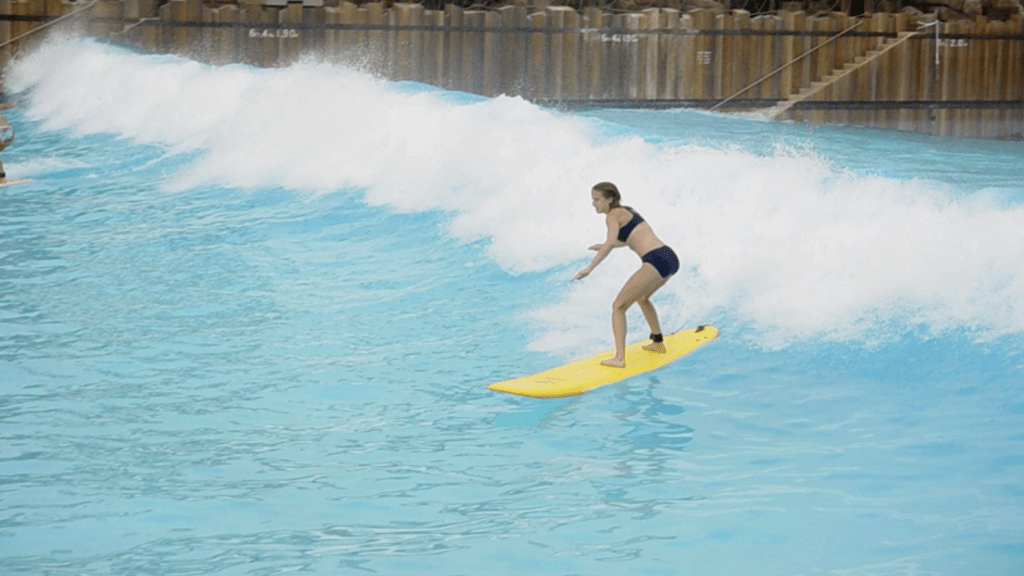
Barr+Wray worked in conjunction with Whitewater to produce the surf at Typhoon Lagoon (although Murphys Waves also claims credit for the Orlando pool). The system uses water to displace water – incredibly effective but not very precise – in the creation of waves. It’s a setup that works like the world’s first surf park, Big Surf in Arizona. Likened to a giant toilet because the water is dropped from elevated tanks into the pool to produce waves, the basic premise did kick off the wave pool revolution. Barr+Wray claim design credit for Typhoon Lagoon Florida, Sun City South Africa, Sunway Lagoon Malaysia and a few others.
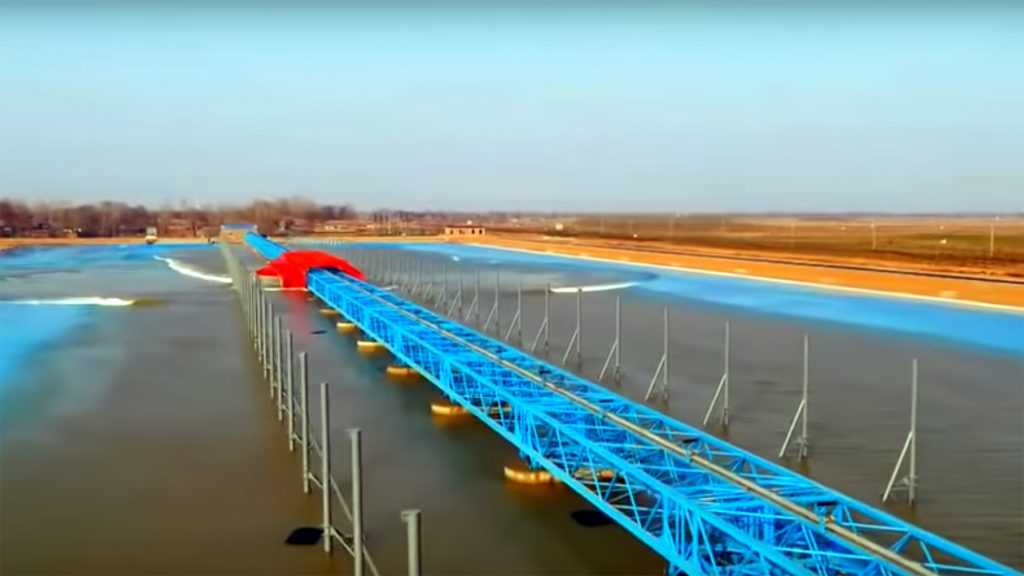
A giant foil runs down a track to produce waves on the right and left sides of a central pier. The Chinese Government is backing this design to train athletes for the Olympics so it’s unknown as to how far this design will extend commercially to the rest of the world. The pool is a 700-meter long rectangle with a width of 150 meters. The central machine’s velocity and foil is adjusted to vary wave size and type. Wave frequency is low, even by plow standards with a right and a left generated once each six minutes. This is most likely due to water needing to settle between waves. Surf height is in the 2-to-4-foot range with soft-breaking waves.
Some reports state that the wave is hollow at the beginning and at the ending of the plow’s run. As the system’s builders aren’t looking for buyers just yet (meaning no promotional materials) this wave-making device is likely to remain a mystery for quite some time. Location is in China and will probably remain so.
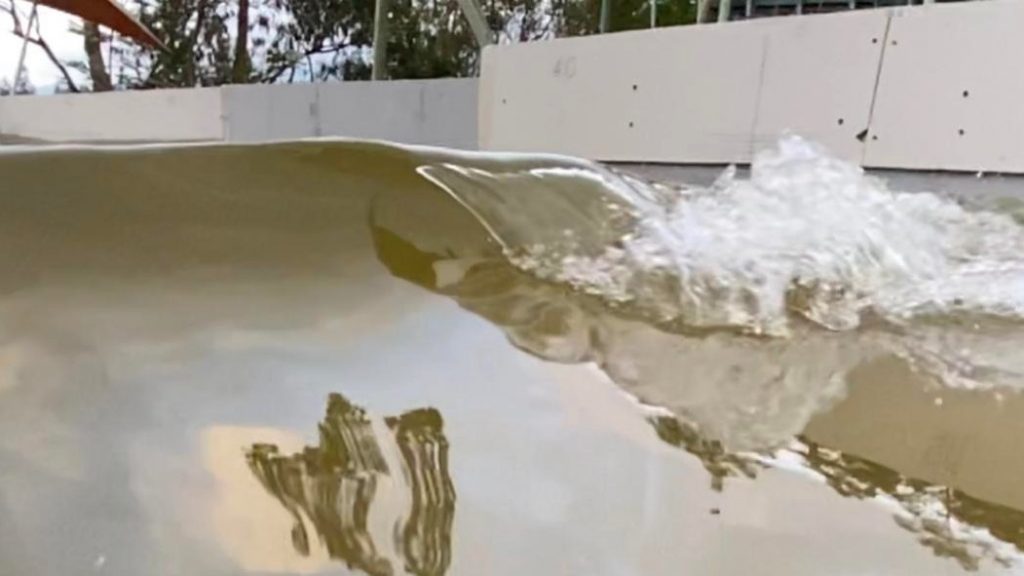
Olas uses a stacking module system similar to Cove wave-generation with differences on the patent-level of things. Powered by what they call their Wave-Master system, it has no compressed-air, hydraulics or pneumatics. The first waves for this system began in 2009 when a British physicist named John Baxendale unveiled his new wave-making system through a “Search for the Perfect Wave” video series. Baxendale experimented as time allowed and in 2014 patented the system. Then in 2018 South American surfer/entrepreneur, Diego Andres Cornejo Rodriquez purchased the intellectual property to create the Olas company.
Current wave frequency is one wave every 12 seconds with the capability to ratchet that up to one wave every nine seconds once they finish their chop mitigation system research. Rides at the planned Quito surf park will hit the two-meter mark and average 16 seconds duration according to Rodriquez. The design will deliver rights, lefts or both at the same time and the company claims that the cost of their wave park would be much less than what is on the market at the moment.
The modular tech can be sequenced with software (similar to Wavegarden and others) will work in a variety of pool configurations and doesn’t require a specific pool shape. “We can actually adapt to different shapes and it can be a triangle, a rectangle, a diamond, or even a circle with 4 split peaks just like Surf Lakes but in a different structure configuration,” says the company. They added that their tech also fits smaller pools for only rights or only lefts using just a few modules. Olas plans to open a surf park in Quito, Ecuador in the next few years.
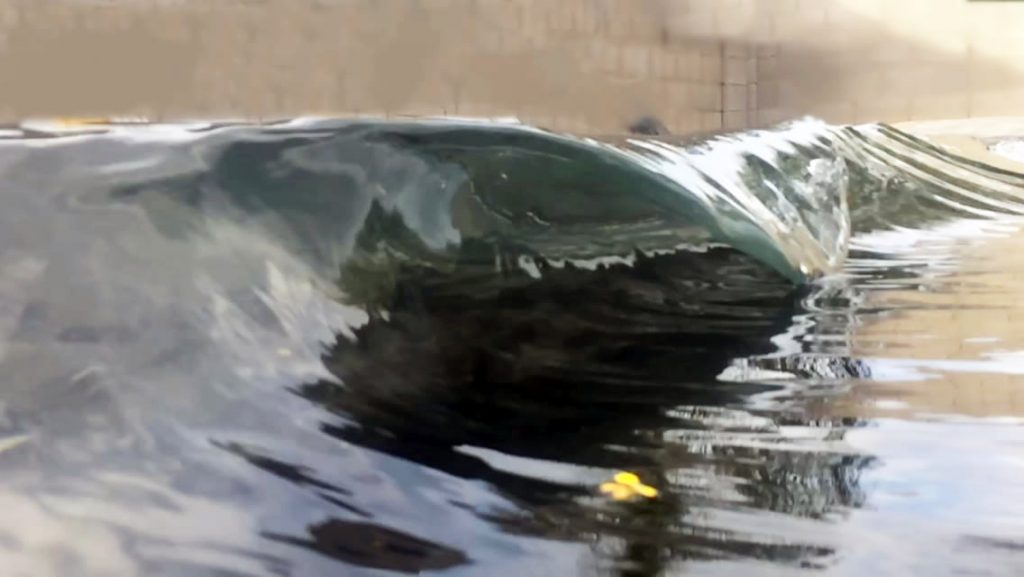
SwellSpot is two components, an engine and a pool. First the engine: Clusters of modules along a wall contain hydraulic plungers that fire in software-controlled sequence to push out swell across a body of water. Plunger stroke height and velocity are adjustable to control the speed and size of the traveling swell. The second component is the bathymetry that determines how the generated swell will break. SwellSpot says pools can be built in any size or shape and create surf-able waves via reefs, points and bays.
The system can work continuously producing waves every 10-15 seconds and operation is easily adjusted for peak and low-frequency use. Wave heights range from 2-to-6-feet but can go bigger with more energy use and a larger pool setting. The system will produce around 360 swells per hour with waves breaking across several different reefs offering a higher surf-able wave count per hour, meaning the same swell is ridden multiple times at different parts of the pool. Plans for a 2.2-acre SwellSpot wave pool list waves breaking for a distance of 75 yards. SwellSpot has plans to build wave pools in Texas and Virginia.
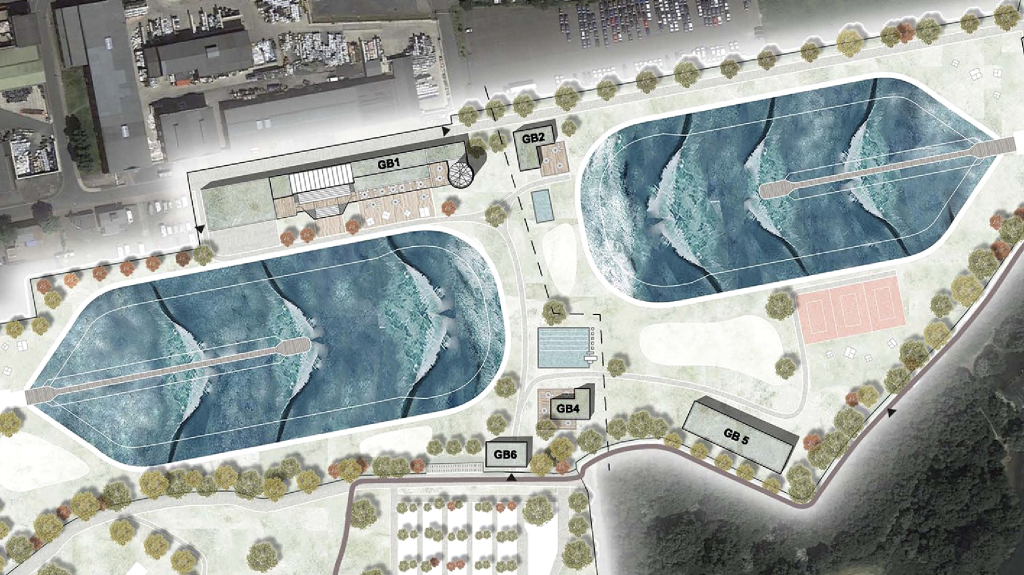
This is a double wave pool facility in Germany and will be constructed on the site of an abandoned coal mine. It’s unknown whether the core of the technology will be pneumatic-powered air chamber waves, levers, plungers, plows or something else entirely. One of the surf pools will be a size-able 300 meters long (Kelly’s Wave is 700 meters long) with the other one slightly smaller. Artist renderings show lefts and rights peeling from the point of a triangle with a short, central pier that then feeds into a long narrow rectangular pool.
Surfwrld said wave height will be 2-6 ft. In the large pool so the length of the wave could be well over 100 yards/meters. The Surfwrld facility along with two German universities (RWTH Aachen and TH Cologne) will use the surf tanks for hydraulic and civil research purposes in the off-season. The team behind the project includes experienced developers, hydraulic engineers, finance and marketing experts working under the management of Dr. Michael Detering. Project logistics and funding is just getting started but hopes to be done by 2023. Once built and proven, the technology could be deployed elsewhere in the world. Location to date is Werne Germany.
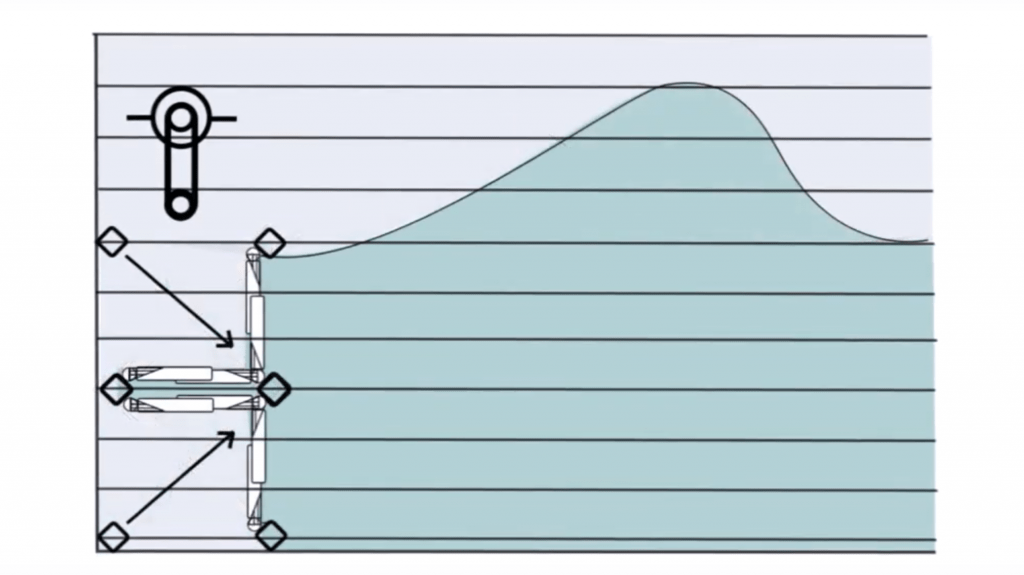
WavePrizm says their wall-piston modular wave machines can produce the world’s most powerful artificially generated waves. The engineers also boast more than 800 waves per hour using 80% less energy than other systems on the market. The company creates surf through modules, and in a wave technology first, also offers full tide range capability. How it works is a bit opaque. Press materials state that the WavePrizm uses diagonal displacement modules with individual water displacement devices (levers or pistons, we aren’t sure) which can be arranged to fit the size and scale of the project.
Swells are produced by firing the mystery modules in sequence. The waves then travel out across the pool, breaking across customized reef bathymetries. The company says they produce a wide variety of waves as well, from easy rollers to standup barrels. Given that the wave pool world seems to have the bulk of its technology-based in pneumatics with only Wavegarden, SwellSpot and a few others lever-based, it’s fascinating to see another addition to lever-powered pools. The company is still in the design and digital assets promotion phase and we’ve yet to see a test tank.
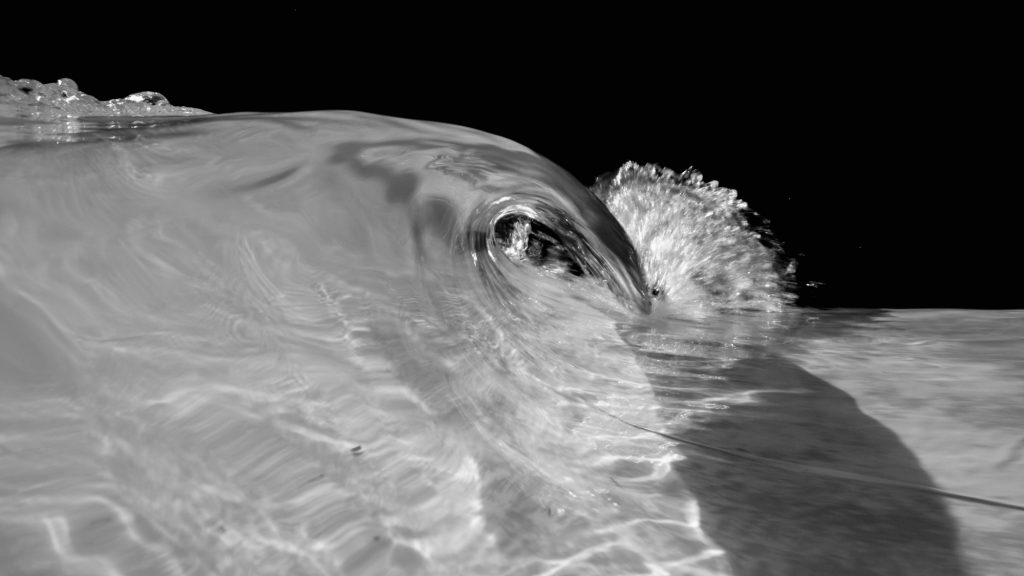
SwellMFG creates waves using pushing levers. Waves come in A-Frame form with surfers splitting the peak rather than a right-session-only or left-session-only option as found in many of today’s wave pools. The company won’t say much except that the system, when combined with their software, offers a “surf playlist” and that their tech can work with nearly any size facility, even very small ones. Expansion to a larger sized facility is made possible with the addition of more modules. They also can drop their system into existing facilities to upgrade the pools for surfing. Wave size ranges from 2-to-6-feet with larger sets possible when given more energy output. Their first full-size wave pool is Revel Surf Park (speculation is that it will be 1.5 acres and offer 10-second rides) and will be located within the Cannon Beach lifestyle destination venue in Arizona.
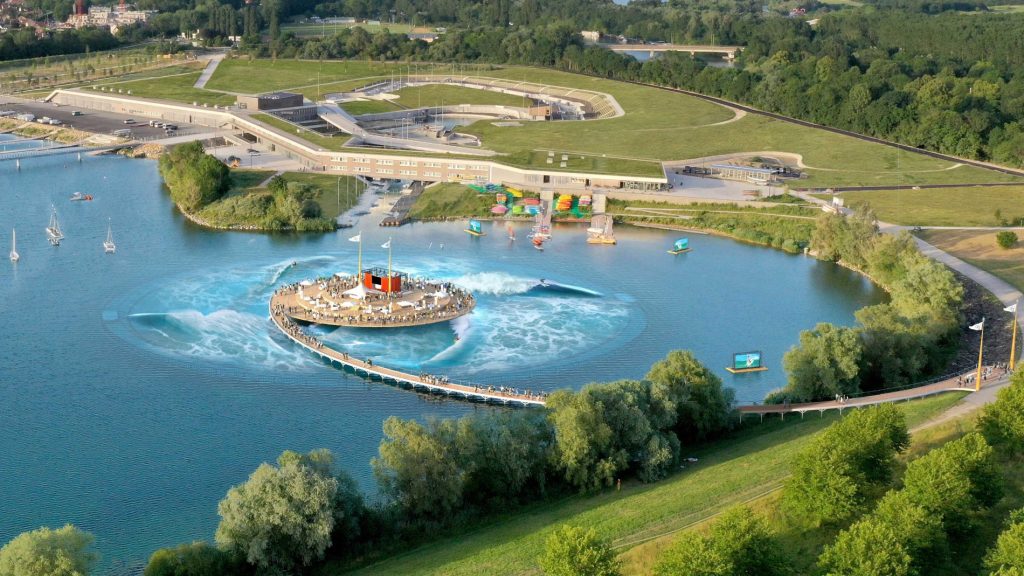
This system is not a wave pool, but a floating wave atoll deployed in lakes, bays and any calm body of water. Based on a spinning motor that directs waves outward along a spiral reef foundation, waves wrap along the spiral for 30-second rides. Max setting produces waves of 6-feet-high and a pier allows spectators to get close to the action. The system generates one wave every 15 seconds. The design is currently being tested in the Aquitaine region of Southwest France at a secret location.
Once deployed the new aquatic reef will attract sea life including mollusks, fish and anything else that feeds on smaller prey that hangs out on reefs. Although the company insists that while it encourages aquatic diversity, it will also provide a natural barrier to jellyfish and sharks. The wave action has the added bonus of oxygenating stagnant bodies of water. Okahina has a handful of locations in the works, all in France. The first will most likely be near Poitiers, adjacent the Futuroscope theme park.
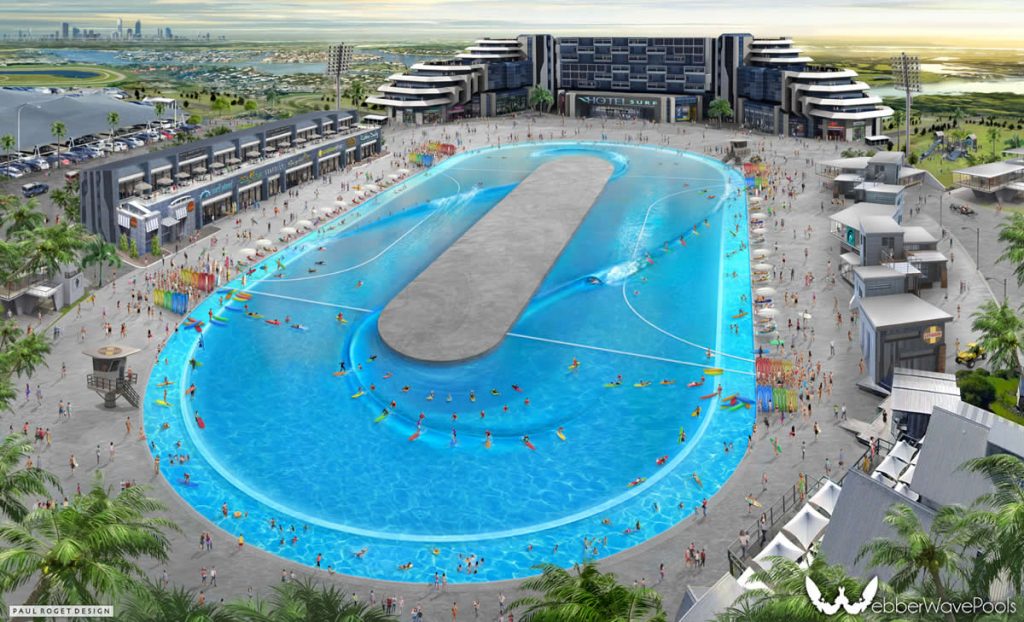
Greg Webber’s fertile mind has been spitting out wave pool and artificial reef concepts for years. His latest is a system on a looped steel rail track fitted with wheeled carriages. “Like a carriage on an urban monorail system,” he says. Wave-making hulls are attached to the wheeled carriages which are driven by electric motors. All of it controlled by hydraulic actuators – those piston-looking things mounted on heavy equipment scoops and blades. The controlling of the carriages helps adjust the wave height, angle, etc.
Still with us? Good. Software controls the speed and the draft and the angle of each hull. Small changes in these three elements result in immediate changes to the wave size and shape. The takeaway? Instead of a fixed plow lumbering down a track pushing out a straight wave, Webber’s wave maker travels along an oval track and has room for several minute adjustments. The system works in conjunction with a current maker which uses a super-secret method of mitigating unwanted currents while also directing them to enhance the waves. The wave pool will produce a 25-second ride with waves in the 5-to-6-foot range with the capability to go up to 7-to-8-feet and producing 120-180 waves per hour. After nearly 20 years of hearing about Webber Wave Pools, Coral Springs Florida is on the map as the first place to develop Webber’s system.
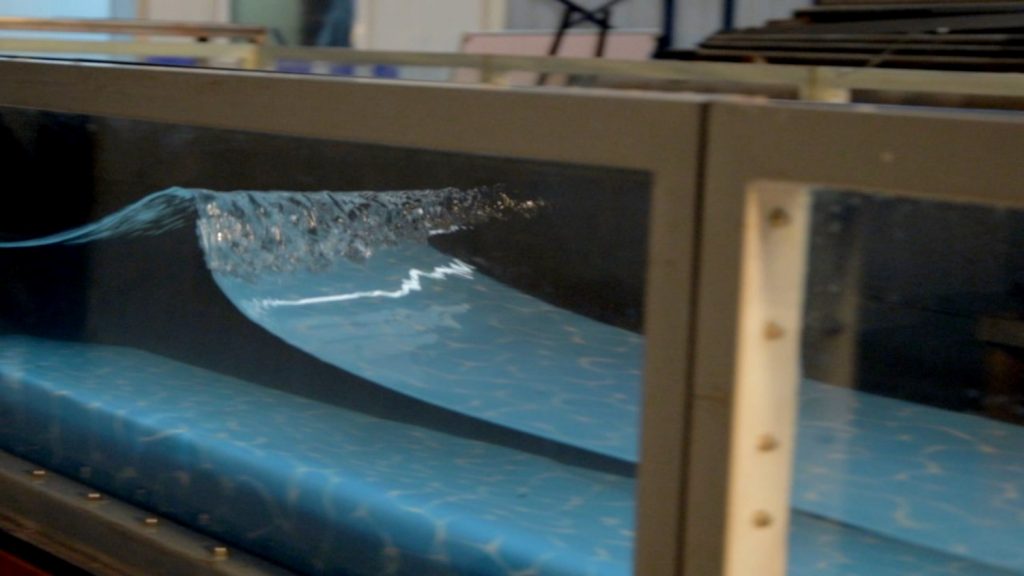
Argentinian company with a fully-funded research warehouse developing the latest pneumatic approach to wave-making. The system is an air-compression-setup much like PerfectSwell, Endless Surf and Surf Loch, all of whom use a technique pushing out air from caissons to displace water and create waves. The WaveSEG system, at least the test models, looks very different because the air cannons are laid out horizontally rather than as vertical concrete chambers at the end of a pool. The company built a small four-cannon model prototype recently to test the theory. This was followed by a full-size air cannon to test the machinery at scale, and now there is a four-cannon full-scale model in the works. A 32-cannon small-scale model is also being developed in the laboratory to assess multi-cannon interaction as well as some other factors. WaveSEG added that their design focuses on energy recuperation via a water return system and said they can recycle that initial energy into the production of the next wave. Expect to see the first full-scale prototype somewhere near Buenos Aires.
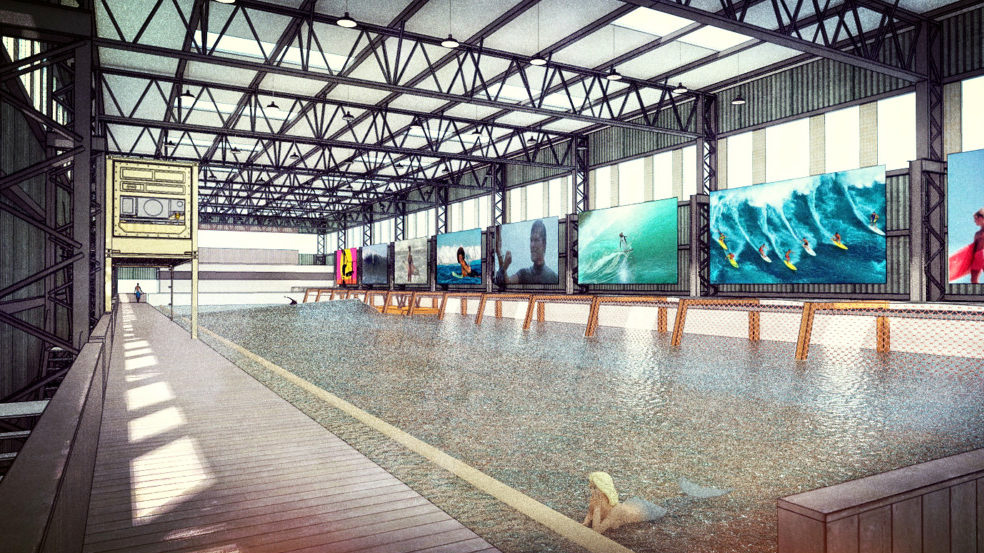
The Dutch indoor wave pool project SurfPoel is fast under construction and hopes to open shortly. Although we couldn’t pin down a specific launch date, from the looks of the social media feed from parent company 24/7 waves, it looks like it won’t be long. When completed the converted warehouse will host a hull and foil type of wave generator created by Australian Steven Schmied. For 10 years Schmied developed a system which can be adjusted to produce a variety of waves. Initial design sketches show a foil-and-track set up to be used inside a long rectangular warehouse. The pool itself will be 72m long (230 feet) and 18m (60 feet) in width with a max depth of 2,5m (8 feet). The building housing the pool is a massive 2400 square meters (7,800 square feet) and will use shipping containers and a timber beach to construct surrounding amenities.
On a larger scale, the company plans to build out their design elsewhere around the world. The surf scene in nearby Scheveningen is lively with a core group of Dutch and visiting German surfers crowding the lineups year-round. Surf Poel will add much-needed reliable surf to the area and reside in The Hague.
247Waves Crowdfunding SurfPoel from 247 Waves on Vimeo.
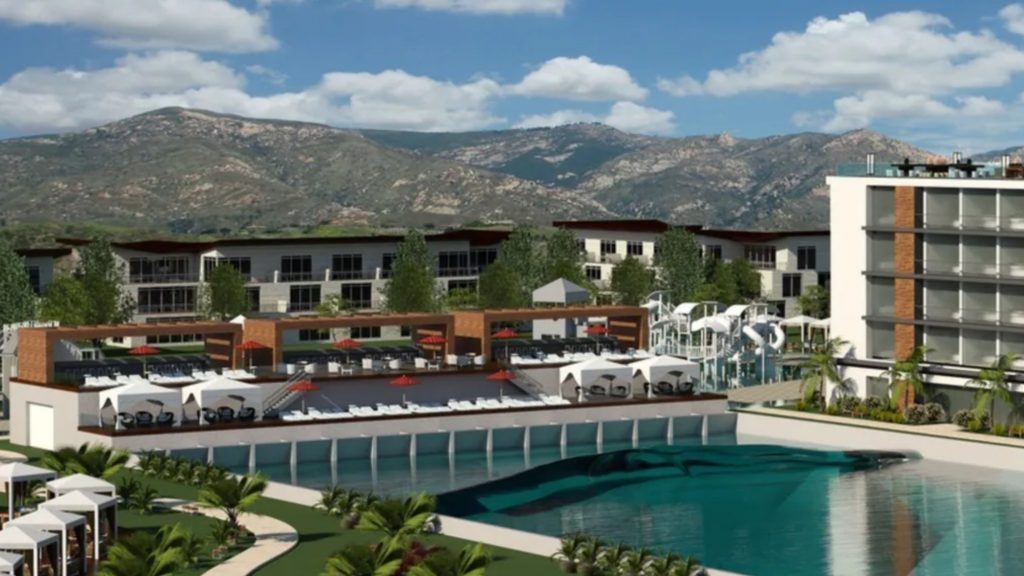
SurfPark Resort is a water park specializing in wave pools for surfing. The company was created in 2015 and is now headed by Fabio Ferraz who says their focus is to bring the Brazilian beach vibe to the world through wave pools. The company stated they have partnered with Bex Global to bring their technology to a worldwide market. For whatever reason, SurfPark Resort is the most secretive of all the technologies we’ve listed, only going as far as to say their system creates simultaneous left and right waves for the same group of surfers during each session and produces waves up to 1.5 meters in height. The first Surfpark Resort is scheduled to open in the second half of 2021 in São Paulo, Brazil. The company also says they provide mobile venues (again without specifics).
Related Coverage
